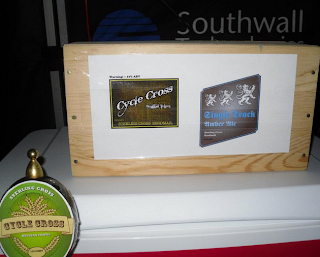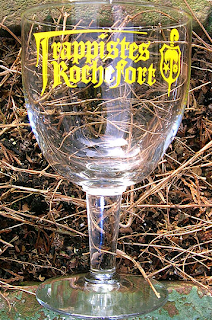it's true, I don't spend my rides, or really any time at all pining for Pliny or desperate for Duvel.
Heretic, outcast, poser....whatever.
I don't know the origins of the beer and cross tradition, but I'm pretty sure it started with the fans in Belgium (12 minutes of a beer tent!!)...and somehow became THE thing.
Which is not to say that I do not appreciate a good beer - indeed my old neighbor has lavished the team with a high quality home-brew such that I actually slept in my car at the BASP Night Race last year...that was a fun party!
Lots of my friends drink beer after they race, but I always feel a little odd-man-out when I don't have that beer taste..which is what it comes down to. Post exercise it just doesn't taste very good sometimes. Must be my highly developed palate...then again wine is no more appealing. Back to the beer...
Seems there are about 170 different Belgian breweries making a wide variety of beers including an impressive six of only eight breweries that qualify as "Trappist" - meaning they are brewed in Monasteries with help from the monks and with income from sales supporting the Monastery or social programs they run. Here are the Belgian Trappist Breweries:
- Achel, sells Blonde (8% ABV), Brune (8% ABV), Extra Blonde (8% ABV), Extra Brune (8% ABV).
- Chimay sells Red Label (dark, 7% ABV), White Label (Blonde/Tripel, ABV 8%) and Blue Label (dark, 9% ABV).
- Orval sells a "unique"[5] dry hopped 6.2% amber beer.
- Rochefort sells three dark beers, "6" (7.5% ABV). "8" (9.2% ABV) and "10" (11.3% ABV).
- Westmalle sells Dubbel (7% ABV) and Tripel (9% ABV),
- Westvleteren sells Green Cap or Blonde, (5.8% ABV), Blue Cap (dark, 8% ABV) and Yellow Cap (dark, 10.2% ABV).
Of course, other monasteries produce beer, but these are merely Abbey brews (non certified), or they may simply have a monastic slant to their marketing, it seems pretty free form on that criteria, so in 1999 they came up with an Abbey certification to help differentiate and by 2011 there were some eighteen certified Abbey beers (from wikipedia):
- Abbaye de Cambron, brewed in Silly by Brasserie de Silly.
- Abbaye de Bonne Espérance, brewed in Quenast by Lefebvre Brewery.
- Abdij Dendermonde, brewed in Merchtem by Brouwerij De Block (nl)
- Abbaye de Saint-Martin, historically referenced to 1096, is brewed near Tournai by Brasserie Brunehaut.
- Affligem, produced for Affligem Abbey by a Heineken-owned brewery.
- Brasserie de l'Abbaye du Val-Dieu (nl) is located on the grounds of a former abbey.
- Bornem is brewed in Oost-Vlaanderen by Brouwerij Van Steenberge (nl)
- Ename is brewed in Oost-Vlaanderen by Brouwerij Roman (nl).
- Floreffe is brewed to fund a school housed in a former monastery.
- Grimbergen, made by the large Alken Maes brewery for an extant Norbertine abbey.
- Keizersberg is brewed in Oost-Vlaanderen by Brouwerij Van Steenberge.
- Leffe, the Abbey brand of Stella Artois, itself part of the multinational Inbev corporation, is brewed under licence from an extant brewery. It is thought to be the first such arrangement. Leffe has global distribution.
- Maredsous, the Abbey brand of Duvel Moortgat, Belgium's second largest brewer, licensed from Maredsous Abbey.
- Postel is brewed in Opwijk by Brouwerij De Smedt (nl).
- Ramée is brewed in Purnode by Brasserie du Bocq.
- St. Feuillien is a small independent brewery.
- Steenbrugge is brewed in Brugge by Brouwerij De Gouden Boom (nl).
- Tongerlo is brewed in Boortmeerbeek by Brouwerij Haacht (nl).
Then of course there is the glassware. Typically reserved for "Special" beers - those that are stronger or bottled, there are a variety of styles - wikipedia covers it pretty well...
"One of the more common types is the tulip glass. A tulip glass not only helps trap the aroma, but also aids in maintaining large heads, creating a visual and olfactory sensation. The body is bulbous, but the top flares out to form a lip which helps head retention.
A vessel similar to a champagne flute is the preferred serving vessel for Belgian lambics and fruit beers. The narrow shape helps maintain carbonation, while providing a strong aromatic front. Flute glasses display the lively carbonation, sparkling color, and soft lacing of this distinct style.
Chalices and goblets are large, stemmed, bowl-shaped glasses mainly associated with Trappist and Abbey ales. The distinction between goblet and chalice is typically in the glass thickness. Goblets tend to be more delicate and thin, while the chalice is heavy and thick walled. Some chalices are even etched on the bottom to nucleate a stream of bubbles for maintaining a nice head.[citation needed]
In addition to the profusion of glasses provided by brewers, some Belgian beer cafés serve beer in their own "house" glassware. "
I do find it all very interesting...so, I guess I'll keep sampling beers and hope to find that one 'always on' type that will allow me to be accepted by my friends!




